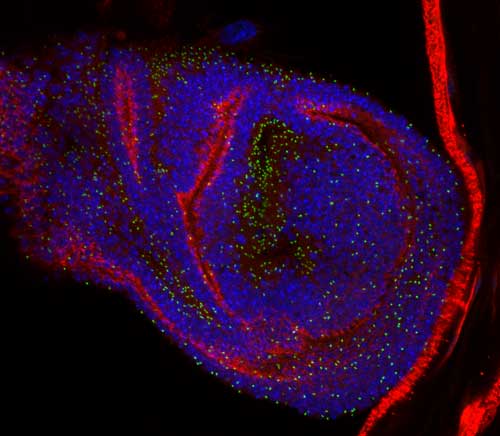Research projects
1. Cytokinesis during development and defects in carcinogenesis
We use the fruit fly Drosophila melanogaster as a model system to study cytokinesis in vivo. Drosophila is a powerful system for detailed genetic, molecular and cell biological analysis of biological pathways in a living organism. Importantly, the cellular machineries governing cytokinesis are highly conserved, and several essential cytokinesis regulators have been identified in Drosophila. The Drosophila model system has also recently emerged as a useful tool to study basic mechanisms of carcinogenesis as shown by the fact that most of the hallmarks of cancer are conserved and that studies in Drosophila have identified novel oncogenes and tumour suppressors.
We are studying the functions of protein complexes involved in membrane trafficking and actin regulation in order to gain knowledge about the molecular mechanisms of cytokinesis in vivo. Interesting candidates will be followed up with studies of cancer phenotypes in Drosophila and evaluated for their relevance in human cancer in collaboration with cancer geneticists. Our recent studies have identified a novel in vivo role of the Drosophila CD2AP/CIN85 orthologue Cindr in regulation of cytokinesis.
2. Mechanisms governing complete versus incomplete cytokinesis
In certain tissues during Drosophila and mammalian development, cells undergo so called incomplete cytokinesis, in which cleavage furrows arrest, giving rise to clusters of cells interconnected by stable intercellular bridges. This is a physiological process that allows intimate intercellular communication and occurs for example in the female and male germline in species ranging from insects to man. However, the mechanisms that determine complete versus incomplete cytokinesis and the functions of stable intercellular bridges in somatic Drosophila tissues are not known. Interestingly, recent studies in human cancer cells with perturbed chromosomal segregation have shown that intercellular bridges become stabilized to delay abscission until proper chromosomal segregation is completed to protect cells against tetraploidization. A better understanding of intercellular bridge stabilization and incomplete cytokinesis in vivo may therefore not only expand the knowledge of these processes during development, but also provide clues to how accurate cytokinesis regulation is achieved to prevent cell division defects associated with cancer development.
We are trying to elucidate mechanisms controlling complete versus incomplete cytokinesis and the functions of somatic intercellular bridges in Drosophila. Recently we have identified Cindr as a novel stable intercellular bridge component and currently analyze how it together with its interaction partners may regulate these aspects of Drosophila development.

|
The image is a projection of several focal planes of a Drosophila larval wing disc epithelium showing Cindr (green) localization at stable intercellular bridges. Cell borders are outlined with Dlg (red) and cell nuclei are shown in blue. |
